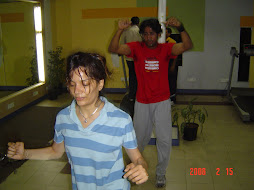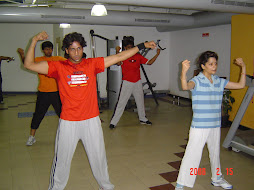
Eat Healthy!
Men - Should have about 1,600 to 2,000 calories a day
Women: Should have about 1,200 to 1,500 calories a day
Choose this many servings from these food groups:
6 starches; 2 milks; 4 vegetables; 4 to 6 ounces of meat, preferaby white meat (Chicken fish) and meat substitutes; 3 fruits maximum up to 4 fats Starches Starches are bread, grains, cereal, pasta, and starchy vegetables like corn and potatoes. They provide carbohydrate, vitamins, minerals and fiber. Whole grain starches are healthier because they have more vitamins, minerals and fiber. Examples of starches are:
* bread * pasta * corn * pretzels * potatoes * rice * crackers * cereal * tortillas *beans * yams * lentils.
What are healthy ways to eat starches?
* Buy whole grain breads and cereals.
* Eat fewer fried and high-fat starches such as regular tortilla chips and potato chips, french fries, pastries or biscuits. Try pretzels, fat-free popcorn, baked tortilla chips or potato chips, baked potatoes, or low-fat muffins.
* Use low-fat or fat-free plain yogurt or fat-free sour cream instead of regular sour cream on a baked potato.
* Use mustard instead of mayonnaise on a sandwich.
* Use low-fat or fat-free substitutes such as low-fat mayonnaise or light margarine on bread, rolls or toast.
* Eat cereal with fat-free (skim) or low-fat (1%) milk.
* Vegetables provide vitamins, minerals, and fiber and they are low in carbohydrate.
Examples of vegetables are * lettuce * broccoli * vegetable juice * spinach * peppers
* carrots * green beans * tomatoes * celery * chilies * greens * cabbage
What are healthy ways to eat vegetables?
Eat raw and cooked vegetables with little or no fat, sauces or dressings:
* Try low-fat or fat-free salad dressing on raw vegetables or salads. * Steam vegetables using water or low-fat broth. * Mix in some chopped onion or garlic. * Use a little vinegar or some lemon or lime juice. * Add a small piece of lean ham or smoked turkey instead of fat tovegetables when cooking. * Sprinkle with herbs and spices. * If you do use a small amount of fat, use canola oil, olive oil or soft margarines (liquid or tub types) instead of fat from meat, butter, or shortening.
Fruits provide carbohydrate, vitamins, minerals, and fiber. Examples of fruit include: apples * fruit juice * strawberries * dried fruit * grapefruit * bananas * raisins oranges * watermelon * peaches * mango * guava * papaya * berries * canned fruitWhat are healthy ways to eat fruits? * Eat fruits raw or cooked, as juice with no sugar added, canned in their own juice, or dried. * Buy smaller pieces of fruit. * Choose pieces of fruit more often than fruit juice. Whole fruit ismore filling and has more fiber. * Save high-sugar and high-fat fruit desserts such as peach cobbler orcherry pie for special occasions.
Milk provides carbohydrate, protein, calcium, vitamins, and minerals.
What are healthy ways to have milk? * Drink fat-free (skim) or low-fat (1%) milk. * Eat low-fat or fat-free fruit yogurt sweetened with a low-caloriesweetener. * Use low-fat plain yogurt as a substitute for sour cream.
Meat and Meat Substitutes
The meat and meat substitutes group includes meat, poultry, eggs, cheese, fish and tofu. Eat small amounts of some of these foods each day. Meat and meat substitutes provide protein, vitamins, and minerals. Examples of meat and meat substitutes includes:
* chicken * fish * canned tuna or other fish * eggs * tofu * cottage cheese * cheese * lamb * turkey
What are healthy ways to eat meat or meat substitutes?
* Buy cuts of ham, and lamb that have only a little fat on them. Trim off the extra fat.
* Eat chicken or turkey without the skin. * Cook meat or meat substitutes in low-fat ways: o broil o grill o stir-fry o roast o steam o stew o microwave
* To add more flavor, use vinegars, lemon juice, soy sauce, salsa, ketchup, barbecue sauce, herbs, and spices. * Cook eggs using a non-stick pan or with cooking spray. * Limit the amounts of nuts, peanut butter and fried foods that you eat. They are high in fat. * Check food labels.
Choose low-fat or fat-free cheese Fats and Sweets
Limit the amount of fats and sweets you eat. Fats and sweets are not asnutritious as other foods. Fats have a lot of calories. Sweets can be highin carbohydrate and fat. Some contain saturated fats, trans fats, andcholesterol that increase your risk of heart disease. Limiting these foodswill help you lose weight and keep your blood glucose and blood fats under control.Examples of fats include * salad dressing * oil * cream cheese * butter * margarine * mayonnaise avocado * olives. Examples of sweets include * cake * ice cream * pie * syrup * cookies and doughnuts. It’s okay to have sweets once in a while. Try having sugar-free popsicles, diet soda, fat-free ice cream or frozen yogurt, or sugar-free hot cocoa mix.
Other tips include: * Share desserts in restaurants. * Order small or child-size servings of ice cream or frozen yogurt. * Divide homemade desserts into small servings and wrap eachindividually. Freeze extra servings. Remember, fat-free and low-sugar foods still have calories.











